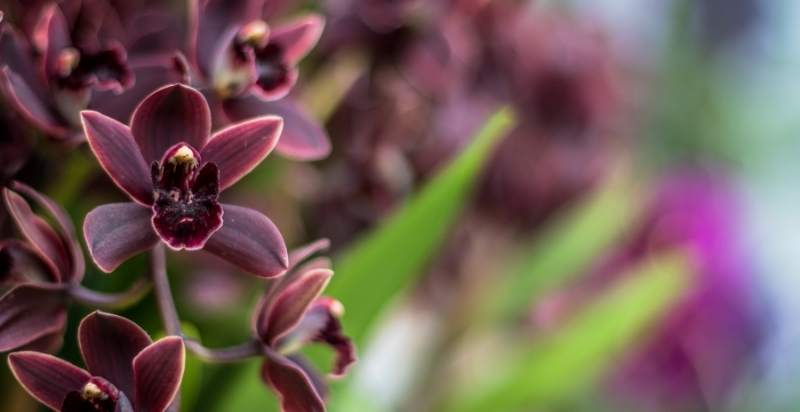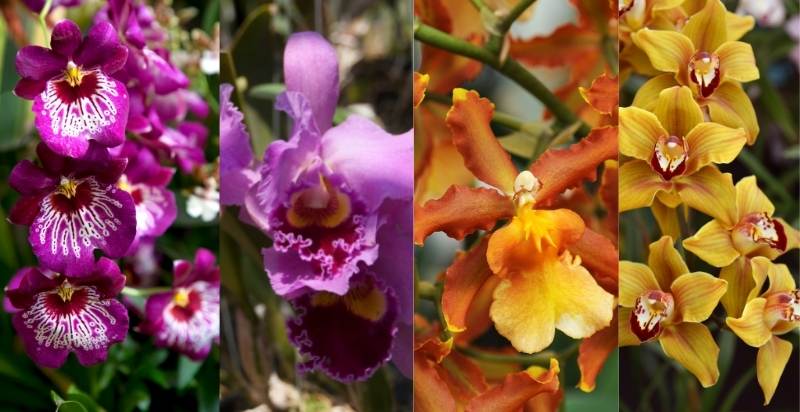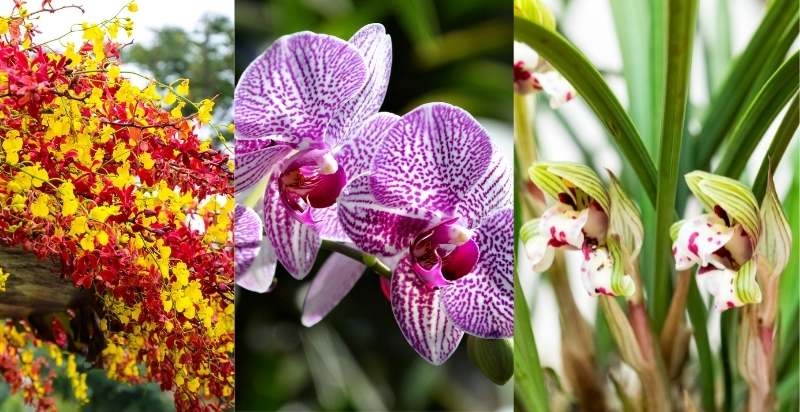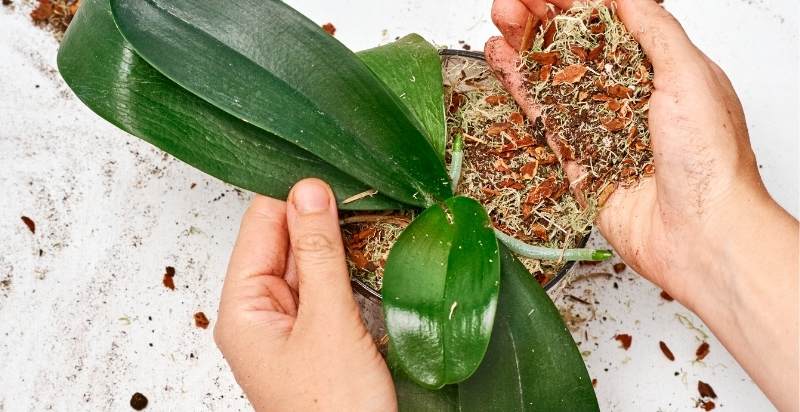If you’re looking for a plant to make a statement in your garden, look no further than the black orchids. These gorgeous flowers are sure to turn heads, and they’re not as difficult to grow as you think.
The black orchid is a striking and unique flower that is sure to add a touch of elegance to any setting. Though they are often associated with mystery and darkness, black orchids can also represent strength, power, and luxury. With a little care, you can have healthy and thriving black orchids in your garden in no time.
This guide will tell you everything you need to know about growing black orchids, including the best varieties to choose, how to care for them, and what to do if things go wrong. By the end, you’ll be an expert on these fascinating flowers.
What are Black Orchids?
Orchid is the largest family of flowering plants, with more than 25,000 species and over 100,000 hybrids. The term “orchid” refers to the shape of the plant’s flowers, which resemble the unique shape of a man’s testicles. Orchids are found on every continent except Antarctica.
Black orchids are one of the world’s most beautiful and unusual types of flowers, and they are also one of the rarest, which makes them even more special. These flowers get their unique color from a pigment called anthocyanin, which is found in very few plants. In most cases, black orchids are an intense shade of purple.

Types of Black Orchids :
The most common type of black orchid is the Miltonia Orchid. These flowers are native to Brazil and come in various colors, from deep purple to black. They have a powerful fragrance and make an excellent cut flower.
Another popular type of black orchid is the Cattleya Orchid. These flowers are native to Central and South America and come in various colors, from pink to almost black. They have a softer fragrance than Miltonia Orchids and make beautiful potted plants.
If you’re looking for something a little different, the Oncidium Orchid is worth considering. These flowers are native to Mexico and Central America and come in various colors, including yellow, brown, red, and black. They have a sweet fragrance and make excellent potted plants.
Finally, the Cymbidium Orchid is a great choice for those who want a black orchid that is easy to grow. These flowers are native to Asia and come in various colors, from cream to black. They have a sweet fragrance and can be grown both indoors and out.

History of Black Orchids :
The black orchid is a species of orchid that is native to Central and South America. These flowers are characterized by their dark purple or black coloration. Black orchids have been used in various ways by different cultures over the years.
In ancient Aztec culture, black orchids were associated with the underworld and were often used in funeral rites. The Aztecs believed that black orchids had the power to guide the dead to the afterlife. In Inca culture, black orchids were associated with resurrection, and it was believed that these flowers had the power to bring the dead back to life.
In more recent times, black orchids have been used in various magical rituals. They are believed to have powerful protective qualities and are often used in spells for warding off evil spirits. Black orchids are also said to help attract love and prosperity.
The Use of Black Orchids in Modern Times
Despite their long history, black orchids remain relatively rare and are not commonly found in gardens. However, they have been used in several high-profile events in recent years. In 2006, Prince Charles and the Duchess of Cornwall attended a state dinner at Buckingham Palace, where they were seated next to each other on a table adorned with black orchids. The flowers also featured prominently at the wedding of Hollywood stars Penelope Cruz and Javier Bardem in 2010.
Despite their rarity, black orchids are becoming increasingly popular as houseplants. Their unusual coloration makes them stand out from other flowers and is known to be relatively easy to care for. A black orchid might be the perfect choice for you if you’re looking for a plant that is sure to turn heads.
How to grow Black orchids?
Gardeners and floral designers for centuries have prized black orchids. Despite their popularity, black orchids are quite difficult to grow, and they are native to tropical regions and require particular conditions to thrive. They can grow on the forest floor in the wild, often near streams or other water sources.
In cultivation, black orchids must be grown in pots so their roots can be properly aerated. They also require high humidity, frequent watering, and bright but indirect sunlight.
If you’re thinking about growing black orchids, you’ll need to choose the right variety for your garden. There are many different types of black orchids, and not all of them will be suited to your climate and soil conditions.
Some of the most popular varieties of black orchid include:
– Oncidium flexuosum: This species is native to Mexico and Guatemala and is one of the hardiest varieties of black orchid. It can tolerate a wide range of climates, making it a good choice for beginner growers.
– Cymbidium goeringii: This variety is native to China and Tibet and prefers cooler temperatures. It’s not as tolerant of heat and humidity as some other varieties, so it’s best suited to gardens in cooler climates.
– Phalaenopsis amabilis: This is a popular black orchid species native to Southeast Asia. It prefers warm and humid conditions, making it a good choice for gardens in tropical or subtropical climates.

How to Care for Black Orchids
Once you’ve chosen the right black orchids for your garden, you’ll need to make sure you know how to care for them. These plants are relatively easy to care for, but there are a few things you need to keep in mind.
Here are some tips for caring for black orchids:
Soil
Orchids need a well-drained yet moisture-retentive potting mix. You can make your potting mix by combining one part sphagnum peat moss, one part perlite, and one part fir bark. Or you can purchase a premade orchid potting mix from your local garden center.
Watering
Orchids should be watered regularly but allowed to dry out between waterings. Over-watering is the leading cause of death for potted plants. The best way to water an orchid is to use a watering can with a long spout and direct the water at the base of the plant, taking care not to get the leaves wet. Water your orchid once a week and more often if it is in a hot, dry location.
Fertilizing
Orchids need to be fertilized regularly to promote healthy growth. Use a balanced fertilizer that contains nitrogen, phosphorus, and potassium. Fertilize your orchid once a month during the growing season and reduce watering and fertilizing to every other week during the winter.
Light
Orchids need bright, indirect light to thrive. If you live in a cool climate, place your orchid near a south-facing window. If you live in a warm climate, place your orchid in an east- or west-facing window. Avoid placing your orchid in direct sunlight, as this will scorch the leaves.
Temperature
Orchids prefer temperatures between 60 and 80 degrees Fahrenheit during the day and 50 to 55 degrees Fahrenheit at night. If you cannot provide these ideal conditions, don’t worry – most Orchids will still do fine as long as they are not exposed to temperatures below 50 degrees Fahrenheit for extended periods.
Humidity
Orchids prefer a humidity level between 40 and 50%. You can increase the humidity around your orchid by placing it on a pebble tray filled with water. The evaporation from the water will increase the humidity in the immediate area. Alternatively, you can use a humidifier to raise the overall humidity in your home.
Pruning
Orchids should be pruned regularly to encourage new growth. Cut back spent flower stems to the base of the plant. Pinch off any dead or dying leaves and remove any yellowed leaves. If your orchid becomes too large for its pot, you can carefully divide it and replant the individual sections in new pots.
Repotting
Orchids should be repotted every one to two years, depending on their size and growth rate. Choose a pot slightly larger than the current pot, as Orchids do not like to be root-bound. Be sure to use a well-drained potting mix and water your orchid immediately after repotting.
Blooming
Orchids typically bloom yearly, although some varieties may bloom more often. The blooming process can take several months from start to finish. To encourage blooming, ensure your orchid gets enough light and fertilize it monthly during the growing season.
Once the flower buds appear, stop fertilizing and reduce watering every other week. After the flowers fade, cut back the spent flower stems to the base of the plant. With proper care, your orchid should bloom again next year.

What to Do if Things Go Wrong
Even if you take good care of your black orchids, things can sometimes go wrong. Here are some of the most common problems growers face and how to solve them:
– Leggy growth: Black orchids can sometimes become leggy, with long stems and few leaves. This is usually caused by too little light. Move your plant to a brighter spot and ensure it gets at least six hours of indirect sunlight daily.
– Yellowing leaves: If the leaves of your black orchid start to turn yellow, it could be a sign of too much fertilizer. Cut back on the fertilizer you’re using, and ensure you follow the manufacturer’s instructions.
– Brown spots on leaves: Brown spots on the leaves of your black orchid are usually caused by too much sun. Move your plant to a spot with indirect light, and ensure it’s not in direct sunlight for more than six hours per day.
– Drooping flowers: If the flowers of your black orchid start to droop, it could be a sign of too little water. Ensure you regularly water your plant and mist it with a spray bottle to raise the humidity.
– Flowers dropping off: If the flowers of your black orchid start to drop off before they’ve fully bloomed, it could be a sign of too much fertilizer. Cut back on the fertilizer you’re using, and ensure you follow the manufacturer’s instructions.
Black Orchid Pests and Diseases
Unfortunately, black orchids can sometimes be affected by pests and diseases. Here are some of the most common problems growers face and how to solve them:
– Aphids: These tiny insects can suck the sap out of your black orchid leaves, causing them to turn yellow and wilt. You can get rid of aphids by spraying them with water from a hose or using insecticidal soap.
– Mealybugs: These small, white insects can infest your black orchid and cause the leaves to turn yellow and wilt. You can get rid of mealybugs by spraying them with water from a hose or using insecticidal soap.
– Spider mites: These tiny spider-like creatures can suck the sap out of your black orchid leaves, causing them to turn yellow and wilt. You can get rid of spider mites by spraying them with water from a hose or using insecticidal soap.
– Fungal diseases: Black orchids can sometimes be affected by fungal diseases like powdery mildew and root rot. These diseases can be difficult to control, so it’s best to avoid them by keeping your plant healthy and stress-free.
If you think your black orchid is affected by a pest or disease, it’s best to contact a professional grower or garden center for advice.
Conclusion
The flowers of black orchids are truly stunning, and they make a dramatic addition to any setting. These flowers typically bloom in the summer months and can last several weeks.
Once your orchids have bloomed, cut back the flower stalks and water them well, and this will encourage new growth and another round of flowers next season.
With proper care, your black orchids will thrive and provide you with years of enjoyment. These unique flowers are worth the effort, and they’re sure to impress anyone who sees them.
- Everything You Wanted to Know About Red Tamarillos - June 2, 2025
- A Guide to Tulips: Everything You Need to Know & More… - June 2, 2025
- Guanabana: Description, Flavor, Benefits, And Uses - May 27, 2025
